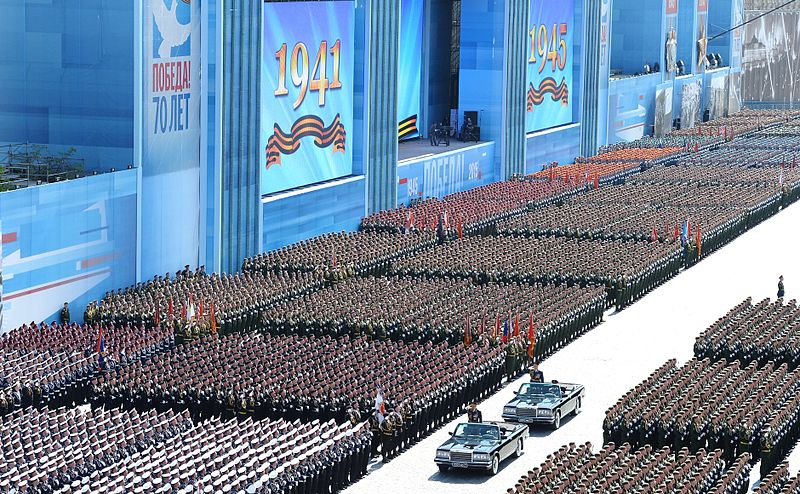Winston Churchill’s “Iron Curtain Speech,” delivered on March 5, 1946 to students at Westminster College in Missouri, serves as a suitable marker for dating the beginning of the Cold War. That the opening salvo of that conflict came from a burst of rhetoric, not artillery fire, is emblematic of a conflict that was primarily fought on the field of ideas. Churchill expressed alarm at the consolidation of autocratic Soviet power over the eastern half of Europe in the aftermath of World War II, and called for the “English-speaking peoples” to unite in opposition to this Soviet expansion. Unbeknownst to Churchill or his audience, two weeks earlier, an American diplomat named George Kennan serving in the U.S. embassy in Moscow cabled a report to the Department of State that later became known as “The Long Telegram.” In this 5000-word missive he implored Washington to reconsider its relationship with its erstwhile Soviet ally, which he accused of being implacably hostile to the post-war order of democracy and human rights sought by the United States. This telegram, along with Kennan’s anonymous publication of a similarly-themed article in Foreign Affairs magazine the following yearentitled, “The Sources of Soviet Conduct,” sounded a clarion call that left a resounding ring in the ears of U.S. policymakers, and set the tone for their approach toward the Soviet Union and worldwide communism for the rest of the Cold War. It spurred President Harry S. Truman to advance the Truman Doctrine of active U.S. support for “free peoples” resisting communism around the world, a strategy designed to “contain” Soviet expansion. This initiative reached its crowning achievements in the Marshall Plan and the creation of NATO.
Kennan understood the Soviet threat in two ways: as the product of Russian history and of communist ideology. Emphasizing the historical approach in The Long Telegram, he believed that Russia’s perennial exposure to nomadic raids sweeping in from the vast Central Asian steppes and repeated invasions from Europe had imbued the Russian people with an almost congenital fear of foreign incursions into their lands. Thus, territorial expansion had became a way of life for the Russian state, a means of creating buffer zones that put distance between the Russian heartland and potential enemies. Kennan noted that this made Russian politics prone to despotism, for Tsars could cloak their absolutism in the legitimacy of protecting their subjects, no matter the cost to their freedom. It also made the Tsars fearful of European intellectual influence in Russia, which they believed had the potential to undermine the quasi-religious legitimacy of their throne. This gave them a vested interest in keeping Russians insular and fearful of the outside world, even whilst periodically attempting to introduce aspects of European modernity to Russian life. In “The Sources of Soviet Conduct,” Kennan argued that Soviet Marxists retained this traditional Russian sense of insecurity, with its attendant rationalization of dictatorship, but interpreted it through a more ‘scientific’ Marxist ideological lens. Essentially, they substituted in their imagination what they assumed were hostile capitalist powers encircling their hard-won socialist state for the nomadic barbarians of medieval Russian history.
The summation of Kennan’s appraisal of the Soviet threat was that Soviet Marxism was simply the latest incarnation of the perennial Russian search for security. “Basically, this is only the steady advance of uneasy Russian nationalism, a centuries-old movement in which conceptions of offense and defense are inextricably confused,” he declared. Despite this overall continuity, Kennan noted that the Marxists’ ideological understanding of Russia’s security dilemma had one unique feature that afforded the United States and its allies a very special opportunity. In Marxist-Leninist dogma, capitalism was seen as inherently unstable and the source of conflict between those nations that embraced it. The consequence of this volatility, so the Soviet line of argument went, was that the democratic-capitalist states would eventually turn on one another, creating breaches that Soviet influence could fill. One of the repercussions of this teleological worldview, Kennan suggested, was that the Soviet regime would be patient and relatively discriminating about when and where it chose to intervene in geopolitical developments. It would be in no hurry to get into trouble, and would back off when confronted by a show of determined resistance. The Soviet leadership, whose interests were intertwined with the bloated domestic security apparatus, was too invested in the business of consolidating power at home to risk the entire Soviet state in dubious foreign adventures. The upshot of all of this, Kennan asserted, was that, “Soviet pressure against the free institutions of the Western world is something that can be contained by the adroit and vigilant application of counterforce at a series of constantly shifting geographical and political points.”
This was the essence of what became known as the policy of “containing” the Soviet Union, a grand game of whack-a-mole in which the United States and its allies would plug power vacuums around the world before they could serve as gaps through which communist influence could rear its head. It required a united front of liberal democracies determined to deny the Soviets the opportunity to politically and militarily intervene in other countries, especially in Western Europe. This made the collective defence mechanism in Article 5 of the NATO treaty critical. It deprived the Soviets of the ability to expand by conquering Western Europe in a piecemeal fashion. If the Soviets attempted to wiggle a brick loose from the defensive wall of the Atlantic Alliance, it threatened to fall on top of them altogether. For this reason, the Soviets never tired of attempting to divide European NATO members from their American allies. Kennan already predicted in 1946, before NATO had been formed, that “Everything possible will be done [by the Soviets] to set major western powers against each other…. No effort will be spared to discredit and combat all efforts which threaten to lead to any sort of unity or cohesion among other [states] from which Russia might be excluded.” As long as NATO remained a cohesive cordon sanitaire, Soviet influence would not metastasize beyond the borders of the USSR.
What the Soviets could not accomplish politically or militarily, impersonal economic forces did not bring to pass either. The doctrinaire Marxist prophecy that “internal contradictions” in the market economy would inevitably lead to conflict between capitalist states proved spectacularly false. On the contrary, the market democracies that made up the NATO community enjoyed a period of peace, prosperity, and mutual trust unparalleled in Europe since the Roman Empire. Countries sought desperately to join this community, not leave it. Ironically, it was the communist bloc that was riven by multiple armed conflagrations, including those between the USSR and China, China and Vietnam, and within the Warsaw Pact itself, in Hungary and Czechoslovakia, until eventually the entire edifice came crashing down.
The end of the Cold War has prompted some voices to call for the dissolution of NATO. The alliance was formed to counter the Soviet threat, so the reasoning goes, and that threat had been neutralized. But the problem with this one-dimensional view of NATO’s reason for being – aside from the fact that the NATO treaty never specifically mentions the USSR – is that it lacks the nuances of Kennan’s original assessment of the Soviet threat. Communism may have been defeated in 1991, and the Soviet territorial empire along with it, but it must be recalled that, for Kennan, this had merely been the latest ideological garb in which Russian national self-understanding had been dressed. The issue of Russia’s insecurity, with its implications for Russian behaviour, persists.
Russia has all but abandoned Marxism and embraced a crony version of the capitalist system it used to fear, yet its political leaders continue to insist that Russia is being “encircled.” Some realist voices make the implausible argument that NATO enlargement is at the root of Putin’s strained relationship with the Western democracies, and even that it has indirectly led to the rise of the police state in Russia. However, this implies that Putin’s despotic tendencies would somehow not exist had NATO remained behind the Oder River, a dubious proposition at best when applied to someone who, by all objective accounts, has systematically snuffed out civil liberties in Russia. It also ignores Putin’s wistfulness about the Soviet Union. A far more plausible explanation for Russia’s siege mentality is that Putin assiduously promotes and exploits the narrative of foreign “encirclement” so as to justify his increasingly dictatorial and kleptocratic domestic rule, much like the Tsars and Soviets did before him. It seems that for the Putin regime, democracy, which NATO has a good record of spreading, is the foreign menace whose sweep into Russia Putin fears the most. Moscow claims that Western leaders double-crossed Russia by enlarging NATO after an alleged promise in 1990 not to extend membership to any new members after German reunification, an allegation NATO disputes. The Putin government has since used this stab-in-the-back myth to justify Russian territorial aggression and its abrogation of international agreements.
Therefore, far from suggesting the obsolescence of NATO, the extinction of Soviet Marxism in post-Cold War Russia makes the argument for the endurance of the alliance that much stronger when seen in the light of Kennan’s diagnosis of the Soviet threat, for as Kennan saw Soviet ideology as imbuing Russia with a healthy amount of risk-aversion, there is little reason to believe the Putin regime is similarly disposed. Putin cannot point, as the Soviet Politburo did, to ‘scientific’ Marxism and the historical necessity of a “dictatorship of the proletariat” to justify his centralization of power. Nor is Putin a towering figure like Peter the Great, who can appeal to natural charisma or a mystical divine right to rule. Rather, much like Napoleon, he has to rely on scoring a string of ‘victories’ against the United States and its allies in order to maintain his legitimacy as the figure who has restored Russia’s national pride after its humiliation in losing the Cold War. It is plausible that this tenuous position will make Putin less risk-averse than his Soviet predecessors. This has already been manifested in the Putin regime’s provocative interference in the affairs of other states and its penchant for revanchism and irredentism.
Like the Soviet regime that preceded it, Moscow appears hopeful that NATO countries are fractious, both internally and in relation to one another, and it seems eager to take steps to make its dissolution more likely. The Putin regime appears actively engaged in fomenting divisions between and within NATO states by exploiting identity politics in lieu of waiting for class conflict to do the job, as the Soviets might have been expected to do. Much like the Cold War strategy embodied in the Truman Doctrine, NATO’s response should be to close ranks so as to deny Russia the ability to drive wedges between alliance members and conquer them through division, either militarily or politically. The Putin government has a vested interest in discrediting democracy, for that, by implication, justifies his autocratic rule. To this end, NATO is vital as more than just a military alliance, but as phalanx of peoples dedicated to democracy and the rule of law.
The NATO-Russian relationship has shown both change and continuity since the end of the Cold War, but perhaps not as much change as popularly believed. The end of the Cold War ideological conflict between capitalism and communism did not translate into the end of the NATO–Russian rivalry. With malice toward none, it should be borne in mind by NATO states and anyone questioning the relevance of the alliance after the end of the Cold War that concerns over Russian expansionism long predate the rise of Soviet communism. Concern about it never should have ended with it.
Photo: Soviet-style Victory Day parade in Moscow, May 2015, commemorating the victory of the Red Army over Nazi Germany in 1945 by www.kremlin.ru via Wikimedia Commons. CC BY 4.0.
Disclaimer: Any views or opinions expressed in articles are solely those of the authors and do not necessarily represent the views of the NATO Association of Canada.




